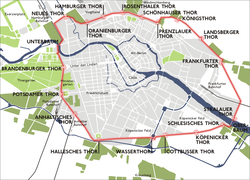Dorotheenstadt Cemetery
Buildings and structures in MitteBurials at the Dorotheenstadt CemeteryCemeteries in BerlinLutheran cemeteries in Germany

The Dorotheenstadt Cemetery, officially the Cemetery of the Dorotheenstadt and Friedrichswerder Parishes, is a landmarked Protestant burial ground located in the Berlin district of Mitte which dates to the late 18th century. The entrance to the 1.7-hectare (4.2-acre) plot is at 126 Chaussee Straße (next door to the Brecht House, where Bertolt Brecht and Helene Weigel spent their last years, at 125 Chaussee Straße). It is also directly adjacent to the French cemetery (also known as the cemetery of the Huguenots), established in 1780, and is sometimes confused with it.
Excerpt from the Wikipedia article Dorotheenstadt Cemetery (License: CC BY-SA 3.0, Authors, Images).Dorotheenstadt Cemetery
Hannoversche Straße, Berlin Mitte
Geographical coordinates (GPS) Address Nearby Places Show on map
Geographical coordinates (GPS)
| Latitude | Longitude |
|---|---|
| N 52.5284 ° | E 13.3837 ° |
Address
Luther
Hannoversche Straße
10115 Berlin, Mitte
Germany
Open on Google Maps








